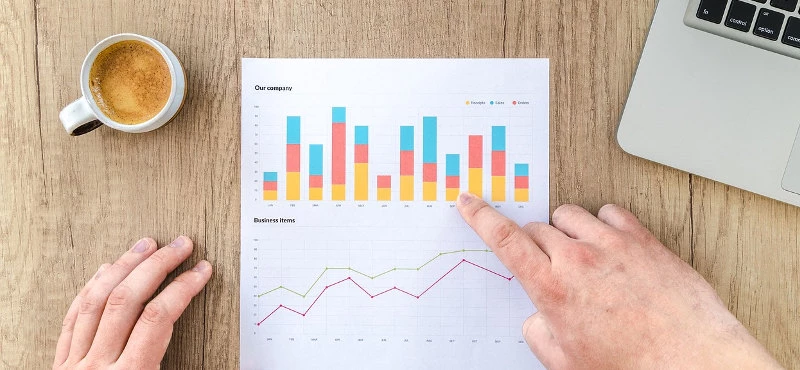Economic Profit Calculator
Understanding economic profit

Knowing how to calculate profit is essential for entrepreneurs to make informed decisions about their business operations.
Calculating profit is not a trivial task because there are many different definitions of profit, and the calculation of profit can vary depending on the context and purpose of the analysis. For example, accounting profit and economic profit are two commonly used definitions of profit that can produce different results.
In this article, we explain the economic profit principle, compare it with alternative methods, and provide the tool to calculate its value for any company quickly.
It takes into account all the costs associated with producing goods or services, including direct and indirect costs, and calculates the profitability.
What is economic profit?
The economic profit (or loss) is the difference between the turnover from the economic activity and the incurred costs.
The costs consist of direct business costs and opportunity costs. The first part of the costs is rather apparent and intuitive, for example, costs of goods sold, rent, salaries, etc.
The opportunity costs are ticky. They represent those implicit costs that are less intuitive. It covers the costs of giving up alternative economic activity. For example, if you quit your job in order to start a new business, the implicit costs would be the difference between the money you make in your new company and your previous job.
The economic profit definition is one of the most basic financial concepts, and its understanding is crucial to running a successful business since the key to entrepreneurship is making the best possible decisions from all possible alternatives.
How to calculate economic profit
The calculator of economic profit requires following the procedure below:
- Find out your revenue for a given period.
- Sum all the explicit costs of your business like rent, payroll, COGS, etc.
- Calculate the missing opportunity costs.
- Fill the data into the form above or substitute it to the formula below.
Economic Profit Formula
economic profit = total revenue - explicit costs - implicit_costs
Explicit costs
Explicit costs are the direct, out-of-pocket costs that a business incurs in the course of producing a good or service. When calculating economic profit, explicit costs are subtracted from total revenue to determine the net profit. Here are some examples of explicit costs:
-
Payroll: The cost of labor, including salaries, wages, bonuses, and benefits, is a high explicit cost for many businesses.
-
Raw Materials and Supplies: Businesses must purchase raw materials and supplies to produce their goods or services. The cost of these materials is a direct cost that must be subtracted from revenue when calculating profit.
-
Rent and Utilities: Rent and utilities, such as electricity, water, and heating, are explicit costs that businesses incur in order to operate their facilities.
-
Marketing: Businesses may need to invest in advertising and marketing to promote their products or services. The cost of these activities is an explicit cost that must be considered when calculating economic profit.
-
Taxes: Businesses must pay taxes, which are explicit costs that reduce profit.
-
Interests: In some cases, debt can be high and have a big share in total business costs.
-
Equipment: The cost of purchasing and maintaining equipment, such as machinery and vehicles, needs to be taken into account when calculating profitability.
Implicit costs
Implicit costs are the opportunity costs associated with the use of resources in a particular business activity. These costs are not reflected in the accounting records but are important to consider when calculating economic profit. Here are some examples of implicit costs:
- Foregone Income: If a business owner invests their own money into the business rather than investing it elsewhere, they are forgoing the opportunity to earn a return on that investment. This foregone income is an implicit cost.
- Time: The time that business owners and employees spend on a particular activity is an implicit cost. This is because the time spent on that activity could have been used for other purposes, such as leisure time or other business activities.
- Use of Assets: The use of assets, such as buildings, equipment, and vehicles, is an implicit cost. This is because the assets could have been used for other purposes, such as renting or selling them for additional income.
- Reputation: The reputation of a business is an implicit cost, as it can be negatively impacted by engaging in certain activities. For example, a business may lose customers or damage its reputation by engaging in unethical or environmentally damaging practices.
- Risk: The risk associated with a particular business activity is an implicit cost. This is because there is a chance that the business may not earn a profit or may incur losses, which is a cost of using resources in that activity.
- Alternative Investments: The potential return that could have been earned by investing in alternative ventures is an implicit cost. This is because the resources used in the business activity could have been used for other purposes, such as investing in stocks or real estate.
The advantages of economic profit over accounting profit

Economic profit considers all costs, including implicit costs, and provides a more accurate picture of a company's financial performance. Here are some of the advantages of economic profit:
-
Comprehensive Metric:
Economic profit provides a more comprehensive measure of a company's profitability than other measures, which only account for explicit costs. Economic profit offers a more accurate representation of the actual cost of production by considering both explicit and implicit costs. -
Better Decision Making:
Economic profit helps businesses make better resource allocation and investment decisions. By accurately assessing the true profitability of different business activities, business owners can make informed decisions about where to allocate resources and invest capital. -
Reflects Opportunity Cost:
Economic profit takes into account the opportunity cost of using resources to grow a business. This means that economic profit reflects the value of resources that could have been used differently, giving a more accurate picture of the true cost of production. -
Encourages Efficiency:
Economic profit encourages businesses to be more efficient by identifying areas where they can reduce costs and increase revenue. This means companies can optimize their operations for maximum profitability, leading to long-term success. -
Better Comparison:
Economic profit allows for better comparisons between different business activities by considering incalculable benefits such as customer satisfaction, brand awareness, or environmental impact. Thanks to this, investors can compare the relative profitability of different activities and make informed decisions about where to invest their resources.
In conclusion, economic profit offers a more accurate and comprehensive measure of profitability that helps businesses make better resource allocation and investment decisions. By taking into account all costs, including implicit costs, economic profit provides a more accurate picture of the true cost of production and encourages businesses to be more efficient.
The limitations of economic profit
While economic profit offers a more comprehensive measure of profitability than other measures, there are some limitations to consider:
-
Difficulty in Estimating Implicit Costs:
One of the challenges of calculating economic profit is estimating implicit costs, such as the opportunity cost of using resources in a particular way. This can be difficult to measure accurately, as it requires making assumptions about what resources could have been used for alternative purposes. -
Dependent on Assumptions:
Economic profit relies on several assumptions about costs, revenue, and opportunity costs. These assumptions may not always hold true and can lead to inaccurate profitability estimates.
Similar tools
There are other financial indicators of profit. For example, EBIT, EBITDA, or NOPAT. All of them could be calculated using tools available here on Calcopolis.

